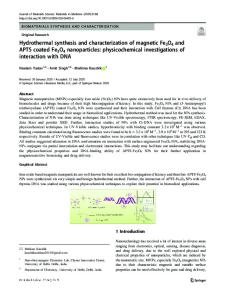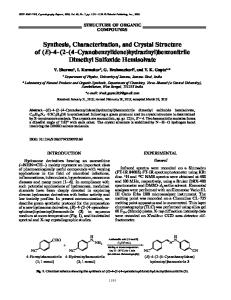Synthesis, crystal structure, and anisotropic thermal expansion of Dy 4.67 (SiO 4 ) 3 O
- PDF / 501,353 Bytes
- 6 Pages / 612 x 792 pts (letter) Page_size
- 3 Downloads / 321 Views
Y. Gao S. DeCarr, and S.C. Bancheri GE Global Research, Niskayuna, New York 12309 (Received 11 January 2004; accepted 26 April 2004)
A new phase in the Dy–Si–O system, Dy4.67(SiO4)3O, was prepared in powder form using the mixed oxide method. Dy4.67(SiO4)3O was first observed at 1300 °C, and phase purity was achieved after 96 h at 1600 °C. The crystal structure was determined using single crystal diffraction using synchrotron radiation, and powder x-ray diffraction data was refined using the Rietveld method. The structure was found to be apatite-type, hexagonal, with space group P63/m and a ⳱ b ⳱ 0.93883(2) nm, c ⳱ 0.67820(1) nm, Z ⳱ 2. High-temperature x-ray powder diffraction was used to characterize the anisotropic thermal expansion over the temperature range of 24–1450 °C, providing the axial and cell volume expansion.
I. INTRODUCTION
Rare-earth silicates have been studied for a wide range of applications from microelectronics to high temperature structural materials. Silicates of yttrium, zirconium, and hafnium have been studied recently for use as high-k dielectrics in composite metal-oxide semiconducting (CMOS) devices,1,2 while doped yttrium silicates are important luminescent materials. 3,4 The orthosilicate, Y2SiO5, has been characterized for use in SiC-based composites because of low oxygen permeability and thermal expansion matching.5–8 The apatite phases of the rare-earth silicates have recently been under investigation because of their interesting behavior as oxide ion conductors.26,27 The apatite form of the rare-earth silicates is cation deficient and the chemical formula can be written as RE 4 . 6 7 䊐 0 . 3 3 (SiO 4 ) 3 O, but will be written as RE4.67(SiO4)3O for simplicity. Structures have been reported for the yttrium,9 cerium,10 gadolinium,11,21 neodymium21 lanthanum, and samarium12 analogs, all of which, except the Nd and Y analogs, are included in the Inorganic Crystal Structure Database.13 Extensive work by Felsche23 included synthesis of the full range of rareearth apatite phases and both powder and single-crystal x-ray characterization. Felsche23 provides lattice parameters for each of the rare-earth apatites from powder diffraction and a single-crystal structure solution for at least the Gd analog. The Powder Diffraction File24 contains
DOI: 10.1557/JMR.2004.0294 2330
http://journals.cambridge.org
J. Mater. Res., Vol. 19, No. 8, Aug 2004 Downloaded: 14 Mar 2015
data for only five variants of the apatite structure: Y, La, Ce, Pr, and Gd. We report here the details of preparation and characterization of the Dy apatite phase, providing additional structural data as well as the first anisotropic thermal expansion data for this class of materials.
II. EXPERIMENTAL PROCEDURE
Specimens were prepared by mixing 99.9% Dy2O3 (Alfa Aesar) and 99.9% SiO2 (Alfa Aesar) under ethanol in an alumina mortar and pestle to form 20 g batches. After mixing and drying, the powder batches were pressed into pellets of 1.9 cm diameter to 90 MPa. The pellets for each composition were stacked into individual
Data Loading...











